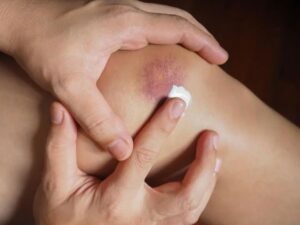
Picture this: you’ve been bustling about your day, the way you usually do, and then you walk into the corner of the table. It’s painful, a little embarrassing, and soon enough, you feel and spot a bruise forming. Bruises are a part of life’s inadvertent bumps; they’re hardly rare, but that doesn’t make them any more pleasant.
While serious injuries might require medical attention, most minor bruises can be taken care of at home. In this comprehensive guide, we’ll walk you through everything you need to know about treating and healing bruises without leaving the comfort of your abode.
Understanding Bruises – More Than Meets the Eye
A bruise, or a contusion, occurs when the tiny blood vessels under the skin are damaged. The blood from these vessels leaks and pools under the skin, causing the tell-tale black, blue, or purple discoloration. This happens with enough force to break blood vessels but not the skin itself.
Sometimes, bruising can indicate serious injuries, especially if you’re on blood-thinning medication or suffer from a bleeding disorder. It’s important to know when to seek medical help.
The Healing Process Unpacked
1. The Immediate Aftermath
Right after a bruise forms, it’s essential to take a moment. Apply a cold compress (like a bag of peas or an ice pack wrapped in a towel) to the area for 15-20 minutes, and then remove for the same amount of time. Repeat this several times in the first 24 hours to reduce swelling and pain.
2. Giving Your Body a Hand
Your body’s healing mechanisms are robust, but you can give them a boost. Rest the affected area, and keep it elevated to reduce swelling. On the first day, avoid activities that increase blood flow, such as hot showers, as they can expand blood vessels and increase bleeding under the skin.
3. Managing the Discomfort
Bruises can be itchy, sore, or tender. Over-the-counter pain relievers like ibuprofen can help manage the discomfort. Do not take these medications on an empty stomach and be mindful of any existing health conditions or conflicting medications.
At-Home Remedies for Speedy Recovery
1. Dr. Ice and Mr. Heat
After the first 24 hours, switch from cold to warm compresses to encourage blood flow, which aids in the restoration of damaged tissue. This can be as simple as soaking a towel in warm water (not hot!).
2. Keep It Moving, Slowly
Gentle exercise can help with the blood circulation around the bruise, but nothing too strenuous. Opt for movements that involve stretching the impacted muscle group without causing pain.
3. Strengthen and Protect
Sometimes, avoiding future bruises is about building your defenses. Wearing protective gear during activities that could cause bruises (like elbow or knee pads) can make all the difference.
Dietary and Lifestyle Tips for Bruise Resistance
1. Eat the Rainbow
A diet rich in fruits and vegetables not only provides essential vitamins and minerals but also helps maintain healthy blood vessels, making them more resistant to bruising.
2. Sunshine and Supplements
Vitamin D is crucial for bone and muscle health. Spending time outdoors and considering a supplement if necessary can bolster the body against bruises.
3. Hydration for Health
Dehydration makes the skin more fragile and prone to bruising, so drink plenty of water. Remember, other fluids and high-water-content foods count towards your daily intake.
When a Bruise Might Mean More
Most bruises are benign and heal on their own. But sometimes, they’re a sign of a more severe problem. Watch out for bruises that:
- Appear for no apparent reason
- Are markedly larger or more painful than usual
- Are accompanied by bleeding elsewhere, such as from the gums
- Occur after a new medication was started
- Persist longer than two weeks without explanation
If you notice any of these signs, consult a healthcare professional for a thorough examination.
Addressing Bruising in Special Situations
Special circumstances may call for specific measures:
Bruising in Children and the Elderly
For these age groups, gentle handling is crucial. In children, observe for patterns of injury that could suggest abuse, and in the elderly, consider that certain medications might make them more prone to bruising.
Bruising and Blood Thinners
Those on blood-thinning medications will generally bruise more easily. While the bruise treatment steps will be the same, it’s essential to manage your condition with your doctor’s guidance.
Bruises in Athletes and Active Individuals
Active individuals often experience bruises due to the nature of their sports. Proper training, recovery techniques, and knowing when to rest can significantly reduce the chances and impact of bruises.
The Takeaway
Healing a bruise is mostly about patience and letting your body do what it does best. But supporting the natural healing process with the right home treatments can make the whole experience a bit more comfortable and perhaps even speed it along. Protect yourself, be mindful of your body’s signals, and if you’re in doubt, always err on the side of caution by seeking professional medical advice.
Here’s to walking through life with a little less bruising, and a lot more grace.


Follow Us